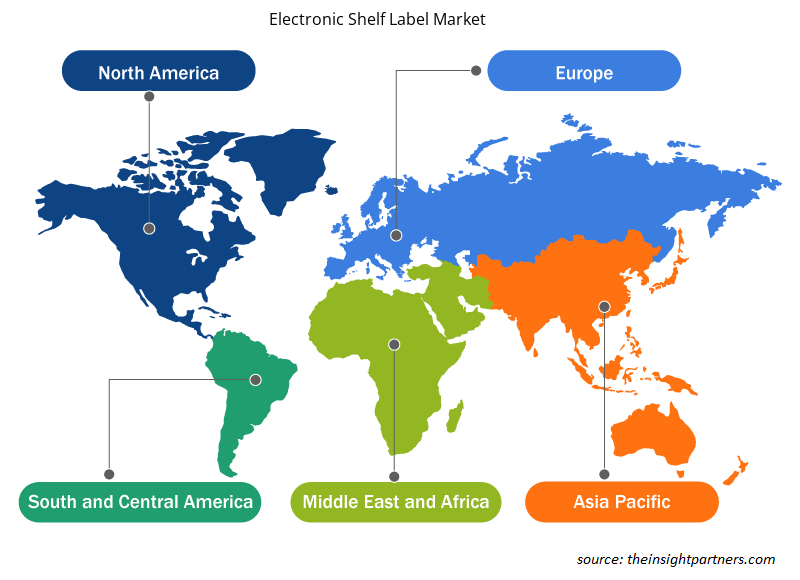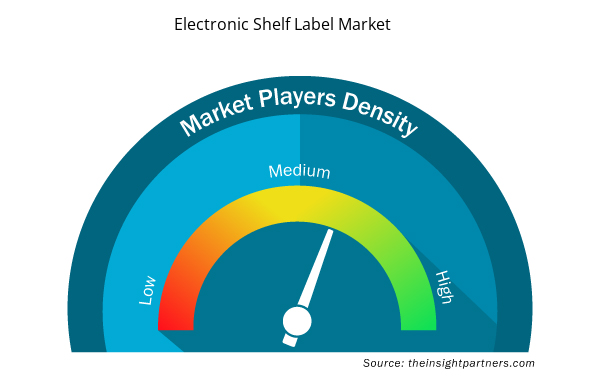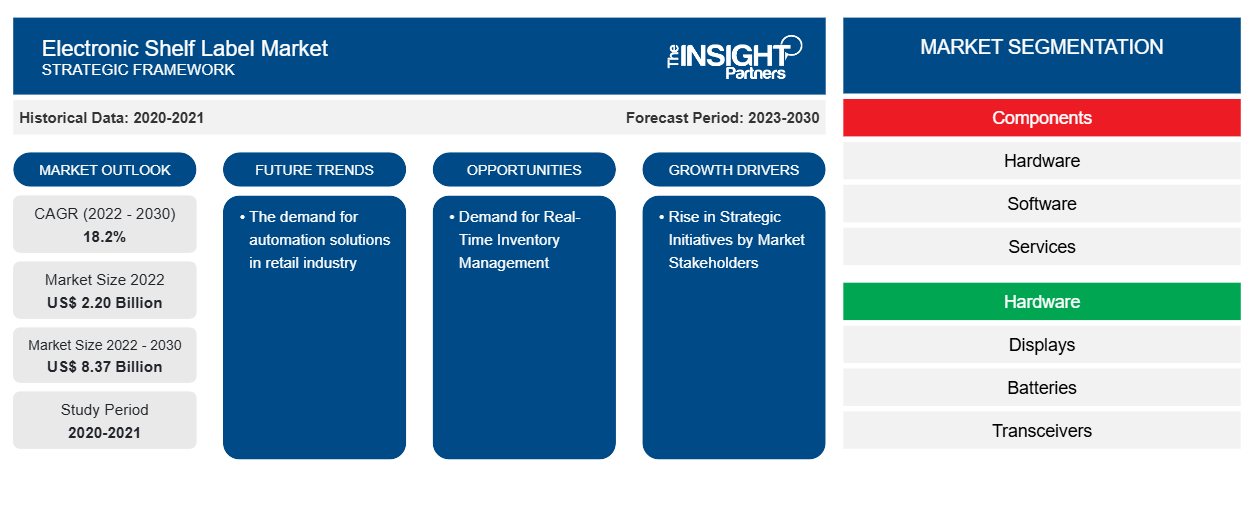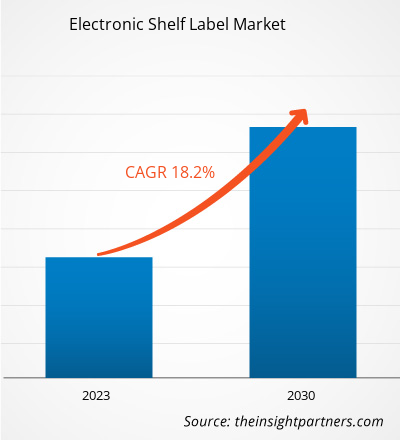预计到 2030 年,电子货架标签市场规模将从 2022 年的 22 亿美元增至 83.7 亿美元。预计 2022-2030 年期间市场复合年增长率将达到 18.2%。零售行业对自动化解决方案的需求可能仍是市场的主要趋势。
电子货架标签市场分析
超市、商场和商店数量增加、劳动力供应减少以及零售自动化需求趋势等因素正在影响电子货架标签市场的增长。然而,系统所需的高昂安装费用和支持基础设施是制约电子货架标签市场增长的关键挑战。此外,世界正在向数字化迈进。由于 ESL 系统的维护成本低,零售业正在广泛采用该系统,因为它为零售商带来了好处。这为在电子货架标签系统市场运营的市场参与者创造了巨大的机会。此外,工业 4.0 集成和 ESL 先进技术的出现,如具有多色和无电池解决方案的电子纸,预计将对电子货架标签市场产生积极影响。
电子货架标签市场概况
零售商使用电子货架标签系统在货架上显示产品价格。该系统正越来越受欢迎,因为它具有诸多优点,例如,每当中央控制服务器更改价格时,产品价格就会自动更新。超市、专卖店和大卖场的数量不断增加,对电子货架标签市场的需求也随之增加。美国、中国、法国、德国和日本是电子货架标签市场收入份额最高的五个主要国家。
定制此报告以满足您的需求
您可以免费定制任何报告,包括本报告的部分内容、国家级分析、Excel 数据包,以及为初创企业和大学提供优惠和折扣
- 获取此报告的关键市场趋势。这个免费样品将包括数据分析,从市场趋势到估计和预测。
电子货架标签市场驱动因素和机遇
市场利益相关者的战略举措不断增加,有利于市场
零售行业的自动化通过减少人为错误,使零售商受益匪浅。此外,全球零售业正在持续增长。例如,根据美国政府的数据,美国零售额从 2019 年的 54023 亿美元增长 3.1% 至 2020 年的 55704 亿美元。根据印度品牌资产基金会的数据,预计到 2032 年,印度零售业的价值将达到 2 万亿美元。零售业越来越强调通过消除与库存、更改价格等相关的商店手动操作来降低总运营成本。因此,整个零售业对自动化解决方案的需求正在上升。此外,自动化的概念还包括在零售店中使用 ESLS 来消除最多的手动任务,这将有助于降低管理费用。
电子货架标签 (ESL) 市场参与者正在推出 ESL,以满足日益增长的零售产品需求。下面提到了一些增长策略。
- 2023 年 1 月,Ynvisible Interactive Inc. 为杂货店零售商推出了大幅面电子货架标签显示器。
- 2023 年 5 月,Pricer & StrongPoint 推出了可以显示黄色、红色、黑色和白色图形的电子货架标签。高分辨率图形和鲜艳色彩的使用吸引了更多顾客并增加了商店的销售额。
因此,市场参与者的此类战略举措推动了电子货架标签市场的增长。
实时库存管理的需求
对实时库存管理解决方案的需求增加了企业对电子货架标签的需求。传统的纸质标签无法为企业提供准确及时的库存水平信息。这可能会导致缺货产品被错误地显示为有货等问题,从而进一步导致客户不满并降低企业销售额。电子货架标签可以整合到零售商的库存管理系统中,以提供实时库存水平更新。这使商店人员能够快速轻松地检测何时需要补充产品,确保客户不会因缺货而感到失望。
电子货架标签市场报告细分分析
有助于电子货架标签市场分析的关键部分是组件、硬件、产品类型、商店类型和通信技术。
- 根据组件,电子货架标签市场分为硬件、软件和服务。2022 年,硬件部分占据了更大的市场份额。
- 根据硬件,市场分为显示器、电池、收发器、微处理器和其他。显示器部分预计在预测期内将有所增长。
- 就产品类型而言,电子货架标签市场分为 LCD ESL 和基于电子纸的 ESL。基于电子纸的 ESL 部分预计在预测期内将实现增长。
- 根据商店类型,市场分为大卖场、超市、非食品零售店、专卖店和其他。大卖场细分市场预计在预测期内将有所增长。
- 根据通信技术,市场分为射频、红外、近场通信和其他。射频部分在 2022 年占据了更大的市场份额。
电子货架标签市场份额按地区分析
电子货架标签市场报告的地理范围主要分为五个区域:北美、亚太、欧洲、中东和非洲、南美和中美。
北美工业制冷设备市场分为美国、加拿大和墨西哥。北美电子货架标签市场受到零售店的大量存在和零售业的重大发展的推动。该地区是世界上大多数大型零售商的所在地。加拿大和墨西哥都有自己最大的零售连锁店,两国都有在全球开展业务的零售公司。零售业占美国 GDP 的近三分之二。美国的主要零售连锁店包括沃尔玛、Albertsons Companies、CVS Health、亚马逊、Walgreens Boots Alliance、Costco、Kroger Co. 和 Target。
电子货架标签市场区域洞察
Insight Partners 的分析师已详尽解释了预测期内影响电子货架标签市场的区域趋势和因素。本节还讨论了北美、欧洲、亚太地区、中东和非洲以及南美和中美洲的电子货架标签市场细分和地理位置。

- 获取电子货架标签市场的区域特定数据
电子货架标签市场报告范围
| 报告属性 | 细节 |
|---|---|
| 2022 年市场规模 | 22亿美元 |
| 2030 年的市场规模 | 83.7 亿美元 |
| 全球复合年增长率(2022 - 2030 年) | 18.2% |
| 史料 | 2020-2021 |
| 预测期 | 2023-2030 |
| 涵盖的领域 | 按组件
|
| 覆盖地区和国家 | 北美
|
| 市场领导者和主要公司简介 |
|
电子货架标签市场参与者密度:了解其对业务动态的影响
电子货架标签市场正在快速增长,其驱动力是终端用户需求的增加,而这些需求又源于消费者偏好的不断变化、技术进步以及对产品优势的认识不断提高等因素。随着需求的增加,企业正在扩大其产品范围,进行创新以满足消费者的需求,并利用新兴趋势,从而进一步推动市场增长。
市场参与者密度是指在特定市场或行业内运营的企业或公司的分布情况。它表明在给定市场空间中,相对于其规模或总市场价值,有多少竞争对手(市场参与者)存在。
在电子货架标签市场运营的主要公司有:
- 标签嵌套
- 显示数据有限公司
- 松下控股公司
- M2C 通信事业部
- 汉朔科技
- Opticon 传感器欧洲有限公司
免责声明:上面列出的公司没有按照任何特定顺序排列。

- 了解电子货架标签市场主要参与者概况
电子货架标签市场新闻和最新发展
电子货架标签市场通过收集一手和二手研究后的定性和定量数据进行评估,其中包括重要的公司出版物、协会数据和数据库。以下列出了电子货架标签市场的一些发展情况:
- 汉朔科技在中国重庆国际博览中心举办了“焕活卓越”新品发布会,正式发布了四色星云系列电子货架标签(ESL)。(来源:汉朔科技,公司网站,2023 年 4 月)
电子货架标签市场报告覆盖范围和交付成果
“电子货架标签市场规模和预测(2020-2030 年)”报告对以下领域进行了详细的市场分析:
- 范围内涵盖的所有主要细分市场的全球、区域和国家层面的电子货架标签市场规模和预测
- 电子货架标签市场趋势以及市场动态,如驱动因素、限制因素和关键机遇
- 详细的 PEST/波特五力分析和 SWOT 分析
- 电子货架标签市场分析涵盖主要市场趋势、全球和区域框架、主要参与者、法规和最新市场发展
- 行业格局和竞争分析,涵盖市场集中度、热图分析、知名参与者以及电子货架标签市场的最新发展
- 详细的公司简介
- 历史分析(2 年)、基准年、预测(7 年)及复合年增长率
- PEST 和 SWOT 分析
- 市场规模价值/数量 - 全球、区域、国家
- 行业和竞争格局
- Excel 数据集


- 3D Audio Market
- Electronic Health Record Market
- Single-Use Negative Pressure Wound Therapy Devices Market
- Aquaculture Market
- Social Employee Recognition System Market
- Animal Genetics Market
- Photo Editing Software Market
- Vessel Monitoring System Market
- Architecture Software Market
- Terahertz Technology Market

Report Coverage
Revenue forecast, Company Analysis, Industry landscape, Growth factors, and Trends

Segment Covered
This text is related
to segments covered.

Regional Scope
North America, Europe, Asia Pacific, Middle East & Africa, South & Central America

Country Scope
This text is related
to country scope.
常见问题
The key players holding majority shares in the global electronic shelf label market are LabelNest, Displaydata Ltd, Panasonic Holdings Corp, M2C Communication DOO, Hanshow Technology, Opticon Sensors Europe BV, Ses Imagotag SA, Samsung Electro-Mechanics Co Ltd, Diebold Nixdorf, Incorporated, and Pricer AB.
The global electronic shelf label market is estimated to register a CAGR of 18.2% during the forecast period 2022–2030.
The global electronic shelf label market is expected to reach US$ 8.37 billion by 2030.
North America dominated the electronic shelf label market in 2022.
The rise in strategic initiatives by market stakeholders is the major factors that propel the global electronic shelf label market.
The demand for automation solutions in the retail industry to play a significant role in the global electronic shelf label market in the coming years.
Trends and growth analysis reports related to Electronics and Semiconductor : READ MORE..
The List of Companies - Electronic Shelf Label Market
- LabelNest
- Displaydata Ltd
- Panasonic Holdings Corp
- M2C Communication DOO
- Hanshow Technology
- Opticon Sensors Europe BV
- Ses Imagotag SA
- Samsung Electro-Mechanics Co Ltd
- Diebold Nixdorf, Incorporated
- Pricer AB
The Insight Partners performs research in 4 major stages: Data Collection & Secondary Research, Primary Research, Data Analysis and Data Triangulation & Final Review.
- Data Collection and Secondary Research:
As a market research and consulting firm operating from a decade, we have published and advised several client across the globe. First step for any study will start with an assessment of currently available data and insights from existing reports. Further, historical and current market information is collected from Investor Presentations, Annual Reports, SEC Filings, etc., and other information related to company’s performance and market positioning are gathered from Paid Databases (Factiva, Hoovers, and Reuters) and various other publications available in public domain.
Several associations trade associates, technical forums, institutes, societies and organization are accessed to gain technical as well as market related insights through their publications such as research papers, blogs and press releases related to the studies are referred to get cues about the market. Further, white papers, journals, magazines, and other news articles published in last 3 years are scrutinized and analyzed to understand the current market trends.
- Primary Research:
The primarily interview analysis comprise of data obtained from industry participants interview and answers to survey questions gathered by in-house primary team.
For primary research, interviews are conducted with industry experts/CEOs/Marketing Managers/VPs/Subject Matter Experts from both demand and supply side to get a 360-degree view of the market. The primary team conducts several interviews based on the complexity of the markets to understand the various market trends and dynamics which makes research more credible and precise.
A typical research interview fulfils the following functions:
- Provides first-hand information on the market size, market trends, growth trends, competitive landscape, and outlook
- Validates and strengthens in-house secondary research findings
- Develops the analysis team’s expertise and market understanding
Primary research involves email interactions and telephone interviews for each market, category, segment, and sub-segment across geographies. The participants who typically take part in such a process include, but are not limited to:
- Industry participants: VPs, business development managers, market intelligence managers and national sales managers
- Outside experts: Valuation experts, research analysts and key opinion leaders specializing in the electronics and semiconductor industry.
Below is the breakup of our primary respondents by company, designation, and region:

Once we receive the confirmation from primary research sources or primary respondents, we finalize the base year market estimation and forecast the data as per the macroeconomic and microeconomic factors assessed during data collection.
- Data Analysis:
Once data is validated through both secondary as well as primary respondents, we finalize the market estimations by hypothesis formulation and factor analysis at regional and country level.
- Macro-Economic Factor Analysis:
We analyse macroeconomic indicators such the gross domestic product (GDP), increase in the demand for goods and services across industries, technological advancement, regional economic growth, governmental policies, the influence of COVID-19, PEST analysis, and other aspects. This analysis aids in setting benchmarks for various nations/regions and approximating market splits. Additionally, the general trend of the aforementioned components aid in determining the market's development possibilities.
- Country Level Data:
Various factors that are especially aligned to the country are taken into account to determine the market size for a certain area and country, including the presence of vendors, such as headquarters and offices, the country's GDP, demand patterns, and industry growth. To comprehend the market dynamics for the nation, a number of growth variables, inhibitors, application areas, and current market trends are researched. The aforementioned elements aid in determining the country's overall market's growth potential.
- Company Profile:
The “Table of Contents” is formulated by listing and analyzing more than 25 - 30 companies operating in the market ecosystem across geographies. However, we profile only 10 companies as a standard practice in our syndicate reports. These 10 companies comprise leading, emerging, and regional players. Nonetheless, our analysis is not restricted to the 10 listed companies, we also analyze other companies present in the market to develop a holistic view and understand the prevailing trends. The “Company Profiles” section in the report covers key facts, business description, products & services, financial information, SWOT analysis, and key developments. The financial information presented is extracted from the annual reports and official documents of the publicly listed companies. Upon collecting the information for the sections of respective companies, we verify them via various primary sources and then compile the data in respective company profiles. The company level information helps us in deriving the base number as well as in forecasting the market size.
- Developing Base Number:
Aggregation of sales statistics (2020-2022) and macro-economic factor, and other secondary and primary research insights are utilized to arrive at base number and related market shares for 2022. The data gaps are identified in this step and relevant market data is analyzed, collected from paid primary interviews or databases. On finalizing the base year market size, forecasts are developed on the basis of macro-economic, industry and market growth factors and company level analysis.
- Data Triangulation and Final Review:
The market findings and base year market size calculations are validated from supply as well as demand side. Demand side validations are based on macro-economic factor analysis and benchmarks for respective regions and countries. In case of supply side validations, revenues of major companies are estimated (in case not available) based on industry benchmark, approximate number of employees, product portfolio, and primary interviews revenues are gathered. Further revenue from target product/service segment is assessed to avoid overshooting of market statistics. In case of heavy deviations between supply and demand side values, all thes steps are repeated to achieve synchronization.
We follow an iterative model, wherein we share our research findings with Subject Matter Experts (SME’s) and Key Opinion Leaders (KOLs) until consensus view of the market is not formulated – this model negates any drastic deviation in the opinions of experts. Only validated and universally acceptable research findings are quoted in our reports.
We have important check points that we use to validate our research findings – which we call – data triangulation, where we validate the information, we generate from secondary sources with primary interviews and then we re-validate with our internal data bases and Subject matter experts. This comprehensive model enables us to deliver high quality, reliable data in shortest possible time.


 获取此报告的免费样本
获取此报告的免费样本